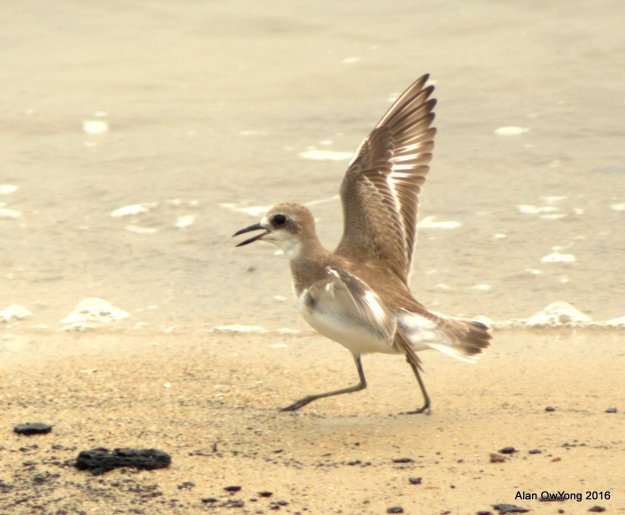
The rising tide forced this flock of Lesser Sand Plovers to roost close up to the dam. Many of them were still in their breeding plumage.
This is an often asked question when an biggish sand plover is seen. On 18th August KC Ling and Timothy Chua posted a photo of a non breeding sand plover with a longish bill taken at Seletar Dam on the Bird Sightings FB page. ID please?. As the bird in the image was a stand-alone, it received different answers from commentators. This was expected since the size of the bird in question, the length of leg and bill can all be very subjective when there are no other birds around for comparison.

This is what one normally sees in the field, a lone hunched plover making identification difficult even at this distance.
But on closer study, some diagnostic features can be discerned. I was lucky to be there on the 27th August morning to photograph the same plover close up in the company of Lesser Sand Plovers (LSP), Charadrius mongolus, during a low high tide to confirm that this plover in question was a Greater Sand Plover (GSP), Charadrius leschenaultii. Let’s take a look at these photos and pick out some distinguishing features to separate these two similar-looking species.

This same plover as above, cropped for a closer look. It has a seemingly horizontal stance and a dumpy appearance – descriptions somewhat fits a Lesser Sand Plover.

The same plover again but now in a more typical upright posture. The taller stance, proportionately larger body and longer (greenish-yellow) legs now makes it easy to identify it as a Greater Sand Plover. This is an adult in the non-breeding plumage having completed a full moult at their breeding grounds before migration.

Generally LSP has darker colored legs than the GSP. But as can be seen here, the left LSP has a paler leg than the LSP on the right. The leg colour should be used as a guide and not as the sole identification feature. Both are juveniles moulting into non breeding plumage.

The GSP has a visibly longer tibia (i.e. upper half of the leg), than the LSP. But in the field it is not always easy to tell as can be seen in this photo. The tibias of the GSP (background) and the LSP (foreground) looks almost the same. But overall the GSP is clearly taller when you have the LSP nearby to compare.

The GSP is a few centimeters larger than the LSP and this size difference is evident in this photo with both species close to each other. But on its own and at a distance it is not that easy to tell.

The size difference is quite obvious in this photo as well. The GSP kept to itself and did not mix with the rest of the Lesser Sand Plovers. It would chase away any LSP that come near. But in this rare occasion, a brave LSP decided to take the fight to the bully.
Apart from the size, posture and leg length of the plovers, a useful feature to separate the two species is the size and shape of their bills. For the LSP (left below), the bill length is slightly shorter than the distance between the bill base and rear of the eye. The bill of the GSP (right below) is visibly longer in this comparison. It is also clearly more robust.
But even this feature is not 100% foolproof in garnering an identification. Some subspecies of LSP, eg. ssp. schaeferi can have bills that appear as long as some individuals of GSP, while some subspecies of GSP (e.g. ssp. columbinus) have bill shapes more similar to the LSP.
One way to tell them apart is to look out for a noticeable bulge on the upper mandible. The LSP bulge is closer to the bill tip giving it a blunt look, while the bulge of the GSP starts in the middle. The bulge near the bill tip of this particular GSP was not particularly visible and that was one reason why the ID remained tentative without the benefit of the size comparison.
Most Lesser Sand Plovers start their migration while still in their breeding plumage and only completely moult into their drabber, non-breeding plumage in their wintering grounds. Most of the early arriving GSPs to our shores have moulted into their non-breeding plumage.
Two Lesser Sand Plovers above. a juvenile on the left and an adult in breeding plumage on the right.

This photo of the GSP shows the broader white wing bars on the primaries and the darker sub-terminal band on its tail. Both are minor features of the GSP.
From this case study, it is clear that it is not that easy to separate the two sand plovers by just looking at one or two features as some of the subspecies of GSP and LSP overlap in some of these features. The size of the bird, length and color of legs, size and shape of the bill, wing and tail pattern, feeding and behavior habits and plumage have to be taken together to come to a proper identification.
Text by Alan OwYong and Yong Ding Li.
All photos taken at Seletar Dam on 24th August 2016 by Alan OwYong. All photos of the Greater Sand Plover are from the same individual.
Reference:
A Field Guide to the Waterbirds of Asia. The Wild Bird Society of Japan 1993. A Field Guide to the Birds of Thailand and South-East Asia. Craig Robson. Asia Books Co. Ltd 2000. A Naturalist’s Guide to the Birds of Singapore. Yong Ding Li, Lim Kim Chuah and Lee Tiah Khee. John Beaufoy Publishing Limited 2013. SASOL Birds of Southern Africa. Ian Sinclair. Struik Publishers. 1993. Identification, taxonomy and distribution of Greater and Lesser Sand Plovers. Erik Hirschfield, Kees Roselaar and Hadoram Shirihai. British Birds 93: 162-189, 2000.



